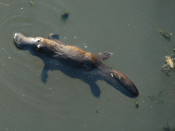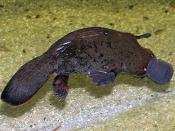The Platypus is a unique Australian mammal. It is a monotreme, a mammal that lays eggs instead of producing live young. It has a bizarre appearance to those that do not live in Australia with its duck-bill, beaver-tail and otter feet. The unique features of the Platypus make it an important subject in the study of evolutionary biology and a recognizable and iconic symbol of Australia; it has appeared as a mascot at national events and is featured on the reverse of the Australian 20 cent coin. The platypus is the animal emblem of the state of New South Wales.
HabitatPlatypus are found only in mainland Australia and the southern island of Tasmania. Platypus are distributed along Australia's east coast, to about 500 miles (800 kilometers) inland, from Cook-town, Queensland to Melbourne, Victoria, and into Tasmania. All platypus live on the edges of freshwater bodies like lakes, ponds, rivers, and streams, in tropical and temperate regions.
DietThe platypus's diet consists of yabbies(various insect larvae), shrimp, crayfish, earth worms, meal worms, May flies, dragonflies, mussels, trout eggs, frog eggs, tadpoles, small frogs and fish. The platypus searches for its food by diving to the bottom of streams and rocking its head from side-to-side through the mud. These dives last for about 40 seconds. When forging on the bottom, the platypus swims with its eyes, ears, and nostrils closed. It uses its electro-sensitive bill to locate and probe for food. The platypus locates its prey underwater by sensing the electric current created by the prey's muscle movements. This is why the platypus is such an excellent hunter at night or in murky water.
ReproductionPlatypus are either solitary, or a male and female may live together, sharing a burrow. Platypus build two types of burrows along the banks of creeks and ponds.


